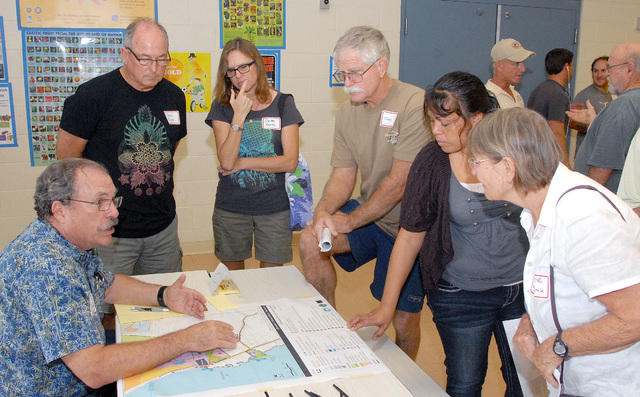Public weighs in on future of Kealakekua Bay
KEALAKEKUA — It was time to hear what the kamaaina wanted.
Residents who said they were never allowed proper input on earlier planning for the future of Kealakekua Bay State Historical Park got a chance to be heard on Saturday as a consultant rolled out options for improving the increasingly popular area.
If the comments from some of the 250 people attending were any indication, the issues are still sticky ones after decades of stop-and-start planning. One thing at least some agreed on, was that the vision being articulated for the bay now is closer to home than they’ve been in the past.
That’s partly because plans have been scaled back.
“It’s been reduced in size considerably,” said resident Gordon Leslie. “The (old plans) were looking to bring a million people a year to the bay.”
But others said the ambitions for the bay haven’t been scaled back enough.
“This is really a place that shouldn’t be turned into Disneyland,” said resident Krista Johnson. “It’s a sacred place; it should be treated that way. Canoe rides to the monument and concession stands would be an affront to the Native Hawaiians who once lived there. It was a working and living place.”
Under the master plan being forged, possible additions to the bay include a canoe shuttle from Napoopoo to Kaawaloa and the Captain Cook Monument, more interpretive trails, a new parking area at the old Gaspar Mill site and a swim and snorkel zone fronting the Captain Cook Monument and Kaawaloa Cove, where powerboats would be prohibited. The plans include an increased presence of enforcement officers, which residents say are sorely lacking.
The first alternative emphasizes recreation. Napoopoo Landing would be opened back up with a dedicated kayak launch and improved water access with a non-commercial vessel drop-off area. The area would also have mobile food concession, portable restrooms and a storage and staging area for the Division of Conservation and Resources Enforcement. A 60-stall parking lot at the Gaspar Mill site would link to the heiau area and Napoopoo Beach with a handicap-accessible trail. A community park and an interpretive program would highlight the area’s archaeology.
A second alternative seeks to balance recreation and historical aspects of the bay, with waterless toilets installed at Kaawaloa, repairs to the wharf to the Captain Cook Monument to allow for canoe shuttle landings and an extensive trail running along the Kaawaloa shoreline. At the Napoopoo heiau area, an interpretive trail would wind through the archaeological sites.
A third alternative emphasizes historical elements, with the restoration of the cultural landscape at Kaawaloa, an interpretive trail that would circuit much of the area, wayside exhibits and a staffed interpretive shelter. Similar interpretive stations and a visitor center with a gift shop and a shelter for the canoe shuttle would be set up on the Napoopoo side.
A fourth “no action” plan would leave the bay as it is.
Many residents wanted to know how the state plans to enforce any new rules it does create for the park and how it will protect its investments.
“There is no enforcement presence down there,” said Iwi Kailua, owner and operator of Aloha Kayak Co., one of three tour companies with a permit to launch from the Napoopoo wharf.
Kailua said that, as a resident of the area, he’s not excited about a lot of change for the bay.
“How it is, is best,” he said. “Most of the people I talk to don’t want a lot of traffic.”
The 550-plus acre park has other issues that aren’t fully addressed in the plan, residents said. One is the Kaawaloa Trail access, which begins on county land, lacks parking and draws daily scores of hikers who have nowhere to relieve themselves after they’ve hiked some 1,300 feet down to the Captain Cook Monument. The droves started coming down the trail when the state banned the landing of vessels at Kaawaloa, Leslie said.
Leslie called on the county to close the trail until the state builds restrooms at Kaawaloa.
“Today, it’s being used as a cesspool,” said Leslie, who also favors creating a two-acre designated rest area for dolphins near the pali, where swimming and boats would be prohibited.
South Kona’s Councilwoman Maile David acknowledged that the county and state need to work together to find solutions.
“There is a place for the county to get involved. There are overlapping jurisdictions,” David said. “I’m glad the state is now involving the community. I want to hear what the community wants, because it is a very special place.”
The comments will help consultants Belt Collins LCC draft their final proposal, which in turn will be subject to more public comment and will lead to an environmental assessment, said John Kirkpatrick, an analyst for the company.
Middle Keei resident Miles Mulcahy had lingering concerns the state could over-build the bay if it’s not careful. He and several others chafed at an option for doing away with a park and pavilion area that has been used by generations of locals.
All told, though, “I’m OK with it, depending on how they do it,” he said. “I’m glad to see the plan is a lot smaller.”
Comments on the plan can be mailed to Kealakekua@bchdesign.com until Feb. 28.
Info: https://dlnr.hawaii.gov/dsp/







